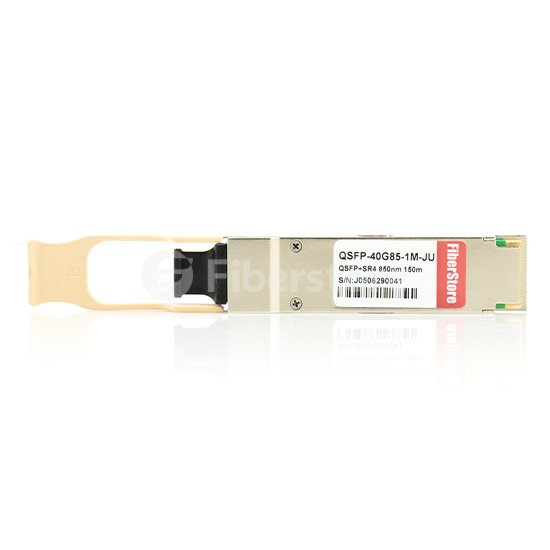Driven by growing bandwidth and network performance demand, data center network infrastructure is witnessing a transformation. The speed of data center now is increasing to 40 Gbps. Thus, new cabling infrastructure and cabling connectivity options are required. Here some commonly used cabling connectivity options for 40Gbps infrastructure will be introduced in this post.
Pluggable Modules: 40G QSFP+ Transceivers
Fiber optic transceiver is an electronic device that receives an electrical signal, converts it into a light signal, and launches the signal into a fiber. It also receives the light signal, from another transceiver, and converts it into an electrical signal. It is the key component in fiber optic transmission. The basic interface of 40G pluggable optical modules are 40GBASE-LR4 and 40GBASE-SR4 QSFP+ form factor.
40GBASE-LR4 QSFP+: 40GBASE-LR4 transceiver support with a link length up to 10 km over 1310nm single-mode fiber. It is most commonly deployed between data centers or IXP sites. The image below shows a Cisco QSFP-40G-LR4 compatible 40GBASE-LR4 QSFP+ transceiver.

40GBASE-SR4 QSFP+: 40GBASE-SR4 transceivers are used in data centers to interconnect two Ethernet switches with 8 fiber parallel multimode fiber OM3/OM4 cables. It can support transmission distance up to 100 m with OM3 fiber and 150 m with OM4 fiber. The optical interface of 40GBASE-SR4 QSFP+ is MPO/MTP. The image below shows a Cisco QSFP-40G-SR4 compatible 40GBASE-SR4 QSFP+ transceiver.

In addition, for single-mode fiber transmission, there are 40GBASE-LR4 Parallel Single Mode (PSM) transceivers which are used to provide support for up to four 10Gbps Ethernet connections on a QSFP+ port over single mode fiber at distances up to 10 km. For multimode fiber transmission, QSFP+ extended SR4 transceivers are developed which is designed with optimized VCSEL with better performance of RMS spectral width compared with QSFP+ SR4. QSFP+ extended SR4 transceivers can support transmission distance up to 300 m with OM3 fiber and 400 m with OM4.
Passive & Active Direct Attach Copper Cables
The QSFP+ passive or active direct attach copper cables are designed with twinax copper cable and terminated with QSFP+ connectors. The main difference between passive QSFP+ DAC and active QSFP+ DAC is that the passive one is without the active component. They provide short distance inexpensive connectivity at up to 40Gbps rates and operate 4 independent 10G channels using the QSFP connector footprint. Each of the four channels can operate at multi-rate speeds Gigabit to 10Gbps. The image below shows QSFP-4SFP10G-CU1M compatible QSFP+ to 4SFP+ passive breakout copper cable.

Active Optical Cable (AOC) Assemblies
Active optical cable uses electrical-to-optical conversion on the cable ends to improve speed and distance performance of the cable without sacrificing compatibility with standard electrical interfaces. QSFP+ AOC is a high performance integrated cable for short-range multi-lane data communication and interconnect applications, for it provides light weight, high performance, low power consumption, low interconnection loss, EMI immunity and flexibility. QSFP+ AOC supports InfiniBand QDR/DDR/SDR, Ethernet (10 and 40Gbps), Fibre Channel (8 and 10 Gbps), SAS and other protocol applications. And hot-pluggable transceiver allows insertion and removal of devices without powering down the system. The image below shows QSFP-4X10G-AOC10M compatible QSFP+ to 4SFP+ active optical breakout cable.

Fiberstore offers a comprehensive solution for 40G fiber optic cabling connectivity. We support a full range of both copper cables and optical transceivers for 40GbE, compliant to the IEEE standards. For copper both QSFP+ to QSFP+ (40G to 40G) and QSFP+ to SFP+ (40G to 4x10G) cables enable short reach options. For longer distances Fiberstore offers a wide range of optical transceivers for various fiber types and reach requirements.
没有评论:
发表评论